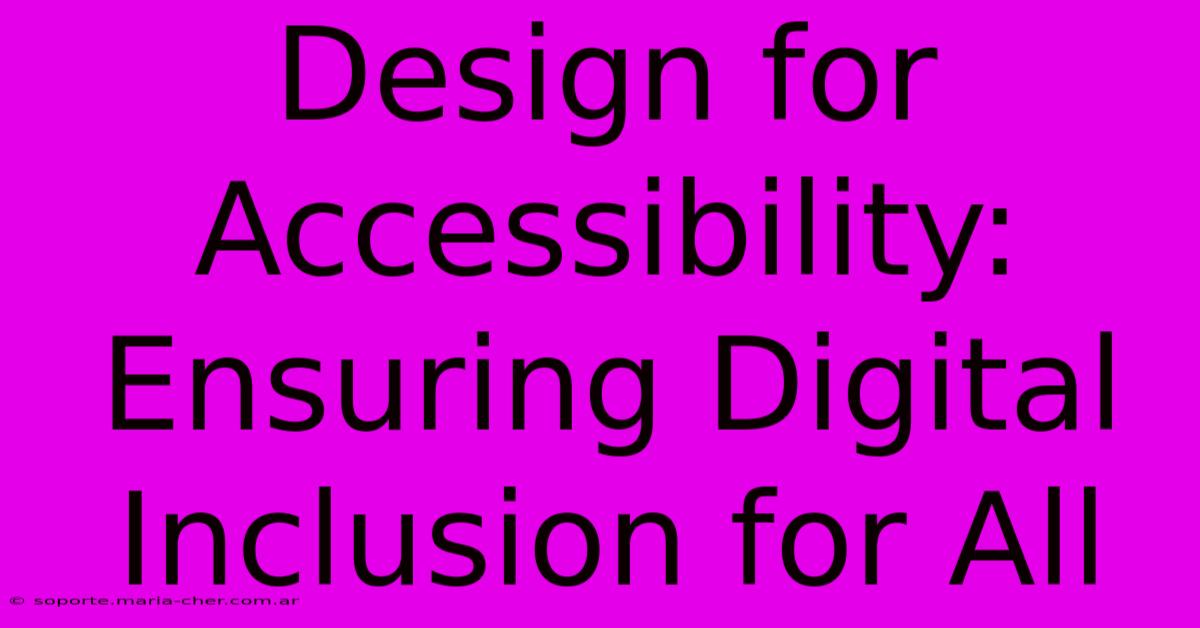Design For Accessibility: Ensuring Digital Inclusion For All

Table of Contents
Design for Accessibility: Ensuring Digital Inclusion for All
The digital world offers incredible opportunities, connecting people, fostering innovation, and driving progress. But for millions, these opportunities remain out of reach due to inaccessible digital design. Design for accessibility isn't just about complying with regulations; it's about building a truly inclusive digital experience for everyone, regardless of ability. This article explores the crucial aspects of accessible design and how to integrate them into your projects.
What is Accessible Design?
Accessible design means creating websites, apps, and other digital products usable by people with a wide range of disabilities. This includes, but isn't limited to:
- Visual impairments: Individuals with blindness or low vision rely on screen readers, alternative text, and sufficient color contrast.
- Auditory impairments: Users with hearing loss benefit from captions, transcripts, and clear visual cues.
- Motor impairments: Individuals with limited mobility need keyboard navigation, adaptable interfaces, and sufficient time limits.
- Cognitive impairments: Users with conditions like dyslexia or autism benefit from clear, concise language, consistent layouts, and easily navigable content.
Key Principles of Accessible Design
Several core principles guide accessible design, ensuring a positive user experience for everyone:
1. Perceivable: Information and User Interface Components Must Be Presentable to Users in Ways They Can Perceive.
- Provide text alternatives for non-text content: Use alt text for images, captions for videos, and descriptions for audio.
- Use sufficient color contrast: Ensure enough contrast between text and background colors to improve readability.
- Provide captions and transcripts for multimedia content: Make audio and video accessible to users with hearing impairments.
- Use clear and consistent language: Avoid jargon and complex sentence structures.
2. Operable: User Interface Components and Navigation Must Be Operable.
- Make all functionality accessible from a keyboard: Avoid relying solely on mouse interactions.
- Provide enough time for users to complete tasks: Avoid time limits that might exclude users with disabilities.
- Design for seizure safety: Avoid flashing or flickering content that could trigger seizures.
- Provide ways to help users navigate and find content: Clear menus, sitemaps, and breadcrumbs are essential.
3. Understandable: Information and the operation of the user interface must be understandable.
- Use clear and simple language: Avoid jargon and complex sentence structures.
- Make content consistent and predictable: Use a consistent layout and navigation throughout your website or application.
- Help users avoid and correct mistakes: Provide clear error messages and ways to undo actions.
- Provide assistance to users who need it: Include help documents and contact information.
4. Robust: Content must be robust enough that it can be interpreted reliably by a wide variety of user agents, including assistive technologies.
- Use semantic HTML: This ensures that assistive technologies can correctly interpret the content of your website.
- Follow accessibility guidelines: Adhere to established accessibility standards like WCAG (Web Content Accessibility Guidelines).
- Test with assistive technologies: Regularly test your website or application with screen readers and other assistive technologies.
Tools and Resources for Accessible Design
Numerous tools and resources can help you create accessible designs:
- WCAG (Web Content Accessibility Guidelines): The gold standard for web accessibility.
- Accessibility checkers: Browser extensions and online tools can identify accessibility issues.
- Screen readers: Use these to simulate the experience of users with visual impairments.
- Accessibility testing services: Professionals can conduct thorough accessibility audits of your digital products.
The Business Case for Accessibility
Accessibility isn't just an ethical imperative; it also makes good business sense. By designing for accessibility, you:
- Expand your reach: You tap into a much larger potential customer base.
- Improve user experience: Accessibility often improves the user experience for everyone.
- Enhance your brand reputation: Demonstrate your commitment to inclusivity and social responsibility.
- Reduce legal risks: You mitigate the risk of lawsuits related to accessibility violations.
Design for accessibility is not an afterthought; it's a fundamental aspect of good design. By prioritizing inclusivity, you create a richer, more meaningful digital experience for everyone, building a more equitable and connected world. Embrace accessibility—it's the right thing to do, and it's good for business.

Thank you for visiting our website wich cover about Design For Accessibility: Ensuring Digital Inclusion For All. We hope the information provided has been useful to you. Feel free to contact us if you have any questions or need further assistance. See you next time and dont miss to bookmark.
Featured Posts
-
Dramatic Bouquets For Daring Brides Unleash The Power Of Hot Pink Flowers
Feb 08, 2025
-
Design For Accessibility Ensuring Digital Inclusion For All
Feb 08, 2025
-
Roses In Bulk The Key To Unlocking Exuberant Events And Stunning Decor
Feb 08, 2025
-
Size Matters Unraveling The Enigma Of W X H And H X W
Feb 08, 2025
-
Red Alert The True Meaning Behind The Most Passionate Rose Color
Feb 08, 2025
